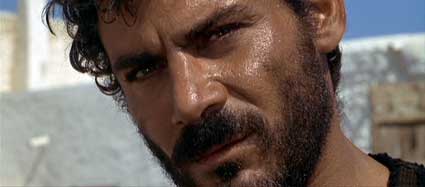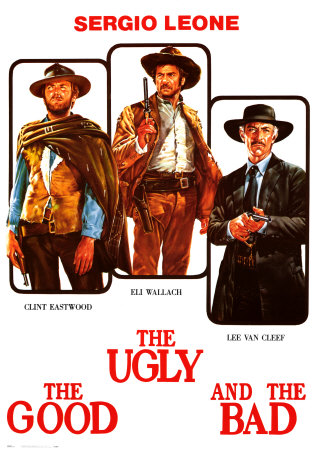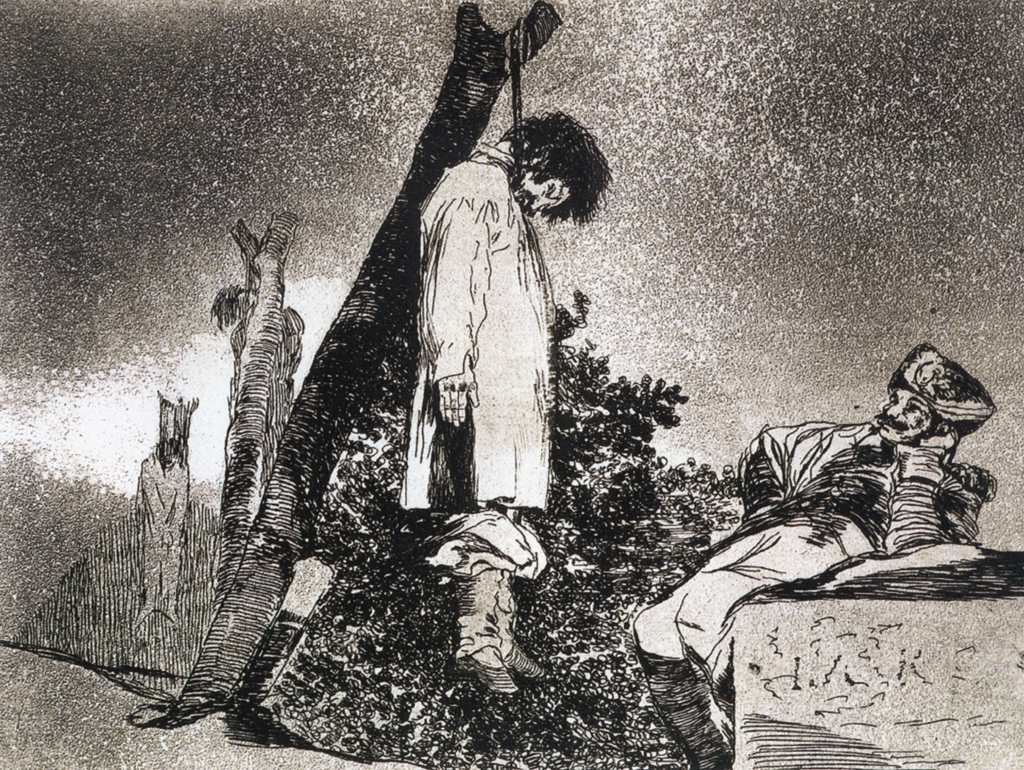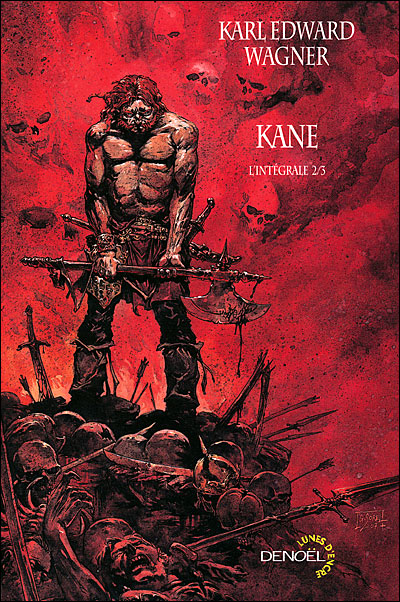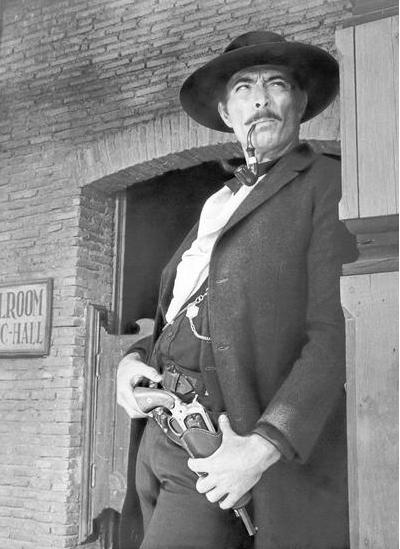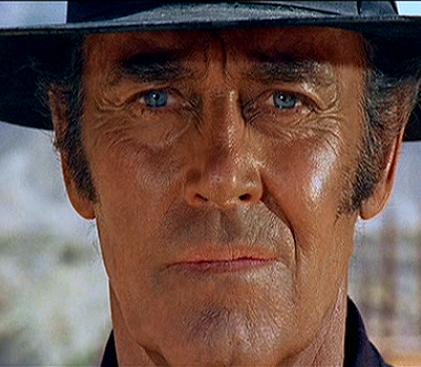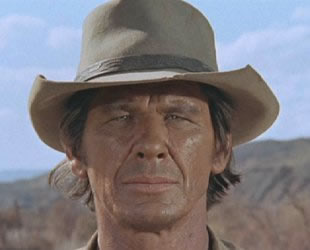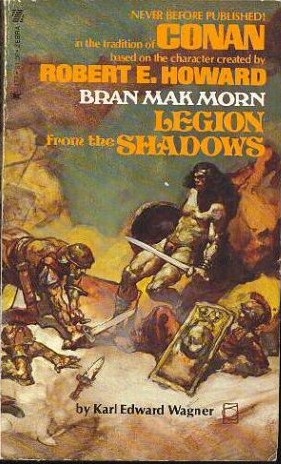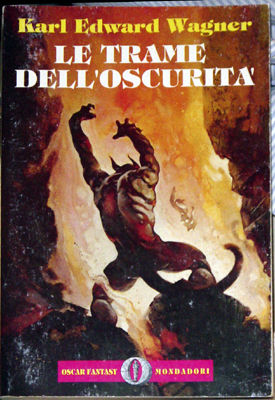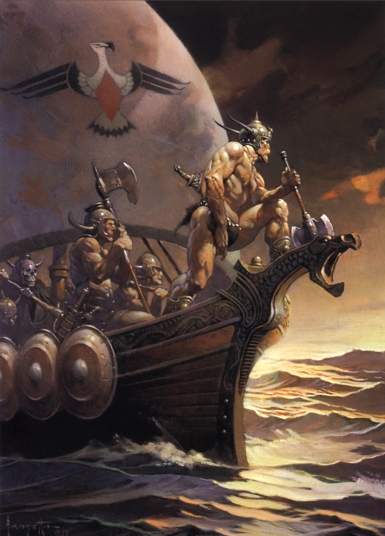Something to Do with Deathlessness, Part Two: Eyes We Dare Not Meet in Dreams
Friday, September 12, 2008
posted by Steve Tompkins
 Print This Post
Print This Post
Part Three: Splintered Shards of Time’s Reflection
For a Few Dollars More is the second film in Leone’s Dollars or “Man with No Name” trilogy and the only one equipped with an epigraph: “Where life had no value, death, sometimes, had its price. That is why the bounty killers appeared.”
They also appear in Wagner’s “Raven’s Eyrie,” the basic situation of which — “ruthless, half-wild outlaws hounded by killers as remorseless as themselves” — recalls For a Few Dollars More, as does the disclosure that “The Combine cities of Lartroxia’s coastal plain had set a high bounty on Kane, and Pleddis meant to claim it.” Colonel Mortimer in the Leone film is out to avenge his sister, who killed herself while being raped by Indio; Ionor, raped by Kane seven years before the events of “Raven’s Eyrie,” does not kill herself but only her maternal instincts while scheming to be her own Mortimer. If Kane seems to be cast in the Indio role in “Raven’s Eyrie,” he behaves like the No Name of For A Few Dollars More in “Sing a Last Song of Valdese,” intervening at the moment of truth to secure another man’s vengeance for a rape and murder. As Leone once said, “An assassin can display a sublime altruism while a good man can kill with total indifference.”
Bounty killers presuppose the existence of men on whom a bounty can be collected, and due to costuming and casting constraints and perhaps a venerable European susceptibility to New World noble savages, spaghetti Westerns tended to ignore Indians and the skirmishing associated with John Ford’s cavalry films in favor of bandits by the dozens and hundreds. Wagner’s repertory company is also chockablock with desperados. In “Sing a Last Song of Valdese” we meet Mad Hef, who is by no means resigned to his capture by Ranvyas the ranger: “There was other smart bastards all set to count their bounty money, but ain’t one of them lived to touch a coin of it.” Hechon in Bloodstone doesn’t know enough to get out of Kane’s way, and Grey’s bandits in “Lynortis Reprise” are particularly Leone-esque: “A circle of grinning wolfish faces, casually moving in across the space of washed stone and dry bones.”
Orted ak-Ceddi in Dark Crusade could be straight from an Italian Western — “for all his pose as a popular hero and champion of the downtrodden, Orted the bandit chieftain had been a ruthless outlaw who left a wake of murder and rapine wherever his band passed through” — and just as Indio’s dependence on marijuana was a departure for a Western in 1965, Wagner’s matter-of-factness about “the tingling rush of cocaine” after Orted has “snorted, sneezed, [and] swallowed” marked an arrival: sword-and-sorcery had caught up with the Seventies.
If anyone anywhere was certain to be simpatico with Leone’s relativist relish in designating No Name as “the Good,” Angel Eyes as “the Bad,” and Tuco as “the Ugly,” it was Karl Edward Wagner, who insisted to Gerald Brown in his 1980 “Raising Kane” interview “A heroic act does not necessarily mean a ‘good’ act.”
“Mirage” takes place in a region where an “uncommonly vicious civil war” has supernatural consequences, and Dark Crusade easily lives down to its Blake-supplied epigraph (And the hapless Soldier’s sigh/Runs in blood down Palace walls), but the Kane story nearest to The Good, the Bad and the Ugly is “Lynortis Reprise.”
Leone’s film and Wagner’s story are as close as the Western and heroic fantasy have come respectively to Goya’s Los desastres de la Guerra.
Leone seized upon the extent to which the American Civil War became a premonition of the trenches on the Western and Italian fronts of 1914–18; “They’re beginning the daily slaughter right on time,” a Union captain who has to stay drunk to function informs No Name and Tuco. Wagner left the medieval panoplies of sword-and-sorcery far behind with “Lynortis Reprise,” superimposing Verdun on Troy in a War to End All Warriors:
He saw a hundred siege engines fire at once, hurling death down upon those below. The night was alive with starbursts of phosphorus flaming across the forests thousands of feet below. And from the attackers arched missiles and stones to smash through the towers of Lynortis and crush those who could not hide. Nowhere was there a place to hide.
Fire raged across the city where flaming balls of pitch and naptha splashed. In the valley below, lethal clouds of black vapor drifted, slaying all in their breath. Women and children fought in the streets for the pitiable rations of food and water that were spared them. Plague stalked them all, in the valley and on the pinnacle. And the cries of the maimed and the dying were as a ceaseless moan of wind.
Leone is quoted in Christopher Frayling’s biography as saying “The Civil War which the characters encounter, in my frame of reference, is useless, stupid: it does not involve a ‘good cause.'” From the Southwestern, self-interested perspective of No Name and Tuco, the Emancipation Proclamation and states’ rights are alien absurdities for abolitionists and secessionists back east to get exercised about. Taking Lynortis is a vanity project for Masale of Westvin; “[he] kept bringing in new troops as fast as they could die,” Hranal remembers. “Lynortis Reprise” is rather like a basin brimming with all the blood lesser sword-and-sorcery authors spill so cavalierly.
At one point in the story Kane surveys a “torture chamber or hospital; the distinction [seemingly] meaningless,” and in the restored/expanded version of The Good, the Bad and the Ugly (released in 2003 and since then available on DVD), even the remorseless Angel Eyes is visibly affected by what he sees while searching for his quarry in a gutted outpost full of wounded Confederates. It is also the Lee Van Cleef character who purchases information from Shorty, a Johnny Reb who has lost both legs. His parting words are “Adios, half-soldier,” and it is quite possible that Wagner had Shorty in mind when he created the half-men of “Lynortis Reprise” — “the creatures of war, the veterans for whom there was no victory, no spoils, no poems and parades.” They do not appear in “The Treasure of Lynortis,” the early ’60s version of the story, and one in particular gets around, and gets around his disability, just as Shorty does:
It was a man — or half of a man. He ran on his hands, legless torso swinging between his thickly muscled arms.
Civil War background noise can lunge to the foreground of The Good, the Bad, and the Ugly without warning, as when the impersonal efforts of an artillery unit to kill many foil Tuco’s highly personal attempt to kill No Name. In “Lynortis Reprise,” an unexploded gas shell alters the outcome when Grey’s brigands are hunting Sesi:
She could see the blackened skin slough away from blistered features as the outlaw leader
screamed mindlessly for a moment longer. And already the black mist had billowed over those who were with him.
Throughout Leone’s film the characters string each other along when they are not stringing each other up; Tuco crosses himself repeatedly but the only real gesture of piety is the Sign of the Double-Cross.
Jeresen’s grievances in “Lynortis Reprise ” — one “bastard was trying to steal the key to a fortune” and another “sold out to Grey for a bigger cut of the gold” — could be those of Tuco or Angel Eyes. The pointed juxtaposition of purposeful murder for private gain and purposeless military murder also drives an exchange in Darkness Weaves; during a sea battle Kane finds time to ask the assassin Arbas how business is. “There’s death enough that the market’s flooded,” the other man laments.
Carnage hard for even the most hardened of killers to take is a theme of The Good, the Bad and the Ugly and “Lynortis Reprise.” “I’ve never seen so many men wasted so badly” is No Name’s comment after he and Tuco witness a failed Union attack. After the dying Byr discloses that he has recognized Kane, Wagner’s protagonist admits having betrayed Lynortis to Masale: “I grew tired of the endless slaughter. . .I wanted it to end.” Wagner told Gerald Brown that his principal concern was “betrayal: characters betrayed by their lovers, their friends, their dreams, their past.” Kane’s betrayal in “Lynortis Reprise” is if not selfless, not entirely selfish either; so often a “Bringer of Death” and “Bringer of the End,” he is this time a “Bringer of Peace” as well, of the only peace that is possible in his world.
Both No Name and Kane take drastic action to put a stop to the squandering of lives; the former is only in a position to end a battle, but the latter ends a war, not once but twice. The best that can be hoped for in The Good, the Bad and the Ugly is that with the bridge blown up, “these idiots will go somewhere else to fight,” but No Name and Tuco win the war because they win something from the war, $100,000.00 in gold each. As it turns out, the gold that causes renewed bloodshed on the blood-drenched battlefield of Lynortis has been spent 30 years before Wagner’s story opens, but Kane wins the war because he survives to say so.
Leone establishes Angel Eyes’ credentials as “The Bad” while introducing the character. Having been hired for 500 dollars by one Baker to extract a name and a life from the crippled deserter Stevens, he is quite willing to accept a thousand dollars for a counter-commission, but then tells Stevens “When I’m paid, I always see the job through.”
After murdering Stevens and his firstborn, he then reports back to the bed-ridden Baker, and mentions the transaction: “I think his idea was that I kill you.” Interrupting Baker’s nervous laughter, he continues, “But you know the pity is, when I’m paid, I always follow my job through.” That he does by pressing a pillow over the old man’s face and pumping four bullets into the pillow. In “Misericorde,” the courtesan Tamaslei loses her lover Josin to the Vareishi and seeks to purchase Kane’s services as an assassin. He explains the rules of the game to her: “If I am offered a fee to perform a certain assignment, I will not accept that fee until I have accomplished it. Taking a fee by force — or accepting an assignment without the certainty that it will be carried out — would be pointless, a bore.”
After executing the assignment in a succinct and surefooted tour de force unequalled by any other Wagner story, Kane apprises his employer of his success in a scene reminiscent of Angel Eyes with Baker:
Tamaslei awoke from dreams of Josin to discover Kane seated beside her bed. It was not a pleasant prospect, and she clutched the fur robes protectively about her silk-clad shoulders.
She turns over the agreed-upon payment, “four bulging leather almoners, a name written in blood upon each heavy purse,” but the night’s business is not quite concluded. Kane directs her attention to a fifth fat almoner, upon which her own name can be read in blood-ink:
“Josin knew you were sending him to almost certain death,” Kane told her, stepping near. “Josin came to see me before he set out, and we made a contract.”
The aphoristic motif of The Good, the Bad and the Ugly — at different times the world is divided into two kinds of people, those with ropes around their necks and those who do the cutting, or two kinds of people, those with loaded guns and those who dig — is echoed in Dark Crusade, where Wagner writes that “There were only two kinds of people left in the world: the Satakis and the inuchiri — literally, “those who betray the one faith.”
No Name’s unusual empathy en route to Sad Hill Cemetery when he wordlessly gives a dying Confederate his coat for warmth and his cigarillo for comfort must have stayed with Wagner, who devised a similar moment in “Misericorde.” Riding to the stronghold of the Vareishi clan, Kane happens upon their handiwork in the form of a victim who has been bound to a tree limb and butchered:
“The Vareishi?” Kane asked, more to prompt than to question.
The boy answered mechanically, like someone speaking from a trance. “We thought to slip past them under cover of darkness. They caught us at daybreak. They said they would leave us here as warning to those who would cross their domain without paying tribute.”
“And afterward?”
“They carried away all to Altharn Keep. They took my sister.”
“Doubtless to be held for ransom. Now, let this powder dissolve upon your tongue; it will ease the pain.” The first was a lie, and the last was not, for Kane was seldom needlessly cruel. The artery beneath his fingertips pulsed weakly until he had counted to twenty-seven, then the heart shuddered and stopped.
Seldom needlessly cruel; in the world as presented by Leone and Wagner, protagonists are “Good” to the extent that they are not as “Bad” as they could be. When sadism is second nature, Samaritanism is as moving as it is atypical.
No Name may have been Vincent Canby’s “perfect physical specter,” but The Man with the Harmonica in Once Upon a Time in the West is both more haunting and more haunted. Even more than in Leone’s previous Westerns, this is a film in which the eyes have it, a film that is best approached, in Richard T. Jameson’s indispensable formulation, as “an opera in which arias are not sung but stared.” Charles Bronson’s otherworldly eyes, glacial lakes or inland seas in the Jornada del Muerte of his face, are matched by, and against, Henry Fonda’s even bluer and more Kane-like gaze; Uncut contributor Kevin Maher recently described the Frank character’s “baby blues” as burning “with savage indifference.”
Leone: “If I include so many extreme close-ups of eyes in my Westerns, it is largely because I want to show that the eyes are the most important feature. Everything can be read in the eyes: courage, menace, fear, uncertainty, death.” The critic Kathleen Murphy sought to read No Name’s ocular text in her 1996 article: “The Good, The Bad and The Ugly: Clint Eastwood as Romantic Hero.” She discerned “a contraction of character so severe that its primum mobile must remain mystery. He is given to intense watchfulness from some inner coign of vantage — hell, grave, or madness.” Kane, of course, has sojourned in hell, grave, and madness, and although prose cannot be film and must remain a forced march to the next paragraph and then the next in which close-ups cannot be held for too long, Wagner does his best:
Kane’s eyes glowed with blue fire in the flickering light, cold death laughing derisively in
their depths. Hechon had always felt a chill when he looked into those eyes, the eyes of a born killer.His eyes. . .Sesi shivered. Cold. Blue. Eyes of a killer. . .eyes that had watched many a man die, had absorbed a fragment of each death, and the essence of death flamed within their blue depths.
Orted’s black eyes held the gaze of Kane’s blue eyes. Eyes dark with cosmic evil: eyes that blazed with azure murder-lust. The secret touch of an elder god: the Mark of Kane. Orted broke the gaze, and broke the tableau.
Elric turned his pink eyes full into Kane’s cold blue gaze. He felt a sudden chill throughout his body.
Two swords shimmered in the smoky light, ringed by a faceless circle of eyes no less pitiless and bright.
Conan wished he could read the lambent moods that flickered behind the veil of Mordermi’s eyes.
His brown eyes gleamed with a fire that might have been called religious fervor, but the light was too intense, unchecked — a hint of the stark madness that blazed within the fires of religious zeal.
Leone told Christopher Frayling that “the rhythm [of Once Upon a Time in the West] was intended to re-create the sensation of the last gasps that a person takes just before dying,” and his masterpiece is “from start to finish, a dance of death.” Darkness Weaves is another such dance, with Kane’s essential unkillability only accentuating the body count all around him; as that exception to the mass extinction rule Arbas points out, “I’ve noticed that people who come into contact with you don’t live long lives.”
We have already mentioned the “Just a man”/”An ancient race” exchange between Frank and Harmonica near the end of Once Upon a Time in the West. Wagner too offers a dying fall in dialogue in “Two Suns Setting.” The giant Dwasslir is about to join his forebears: “That was an age to live in! An age of heroes!” he maintains, his eyes already glimpsing “things beyond this lonely cavern in a desolate waste.” Kane is well aware that he is participating in a Once Upon a Time moment: “A great race, a heroic age — it’s true,” he acknowledged softly. “But I think the last of its heroes has passed.”
All but immobilized by “tuberculosis of the bones” but obsessively flogging his Iron Horse Pacific-ward, Leone’s Mr. Morton is said to leave “two beautiful shiny rails” behind him like a snail’s slime. A harbinger of the oncoming capitalist era, Morton resorts to the methods of the archaic era he is railroading out of existence in furtherance of his transcontinental dream. The equivalent figure in Wagner’s work is Claudius Nero in the Bran Mak Morn pastiche Legion from the Shadows. It is a measure of the author’s skill that his semi-human legate of Legio IX Infernalis stands toe-toe with Howard’s own Bran, Gonar, and Atla and acquits himself admirably if villainously. Bran’s question to the mounted Claudius Nero — “How is it that a crawling thing has learned to ride? — suggests the attitude of Leone’s limber gunmen to Morton; they liken him to a “rotten apple” and “a tortoise out of its shell.” Restricted by his hybrid parentage to the subterranean and subhuman status of a Worm of the Earth, Claudius Nero yearns for Rome as Morton yearns for California. The businessman dies ignominiously, facedown in a puddle of mud that parodies his Pacific reverie; the would-Roman runs afoul of some real legionaries who deride him as “Quintus Claudius Pictus” before crucifying him. Roma Mater does not recognize her bastard son, whose most cherished aspirations are now the cross he has to bear.
Although it amply justifies its own existence before a word is spoken or a shot is fired, Once Upon a Time in the West is also a chrestomathy or compendium culled from American Westerns like High Noon, Shane, Winchester ’73, Man of the West, Johnny Guitar, The Last Sunset, Rio Bravo, The Searchers, and The Man Who Shot Liberty Valance. The Kane series at times threatens to become a history of horror and heroic fantasy, from the Gothic hero/villain underpinnings of Kane himself through the bravura display of Lovecraftian techniques when the backstory of Pellin and the Sorn-Ellyn is recounted in the “Imel’s Tale” chapter of Darkness Weaves. As Wagner confided in an interview, “There’s a lot of in-joke stuff in the Kane stories.”
In addition to the “chapter titles. . .taken from songs or from other book titles,” we should note that Dragar’s every utterance save for his valedictory “Bitch” in “Undertow” is dismally familiar to anyone who has suffered through too much thud-and-blunder. In his 1998 biography Clint Eastwood, Richard Schickel states that “[the Leone films] were fully, wickedly aware of the conventions they were sometimes rendering as ironic abstractions and sometimes completely subverting.” Wagner was equally aware and equally wicked, as he admitted to Gerald J. Brown: “The episode in “The Dark Muse” was carefully set up as a swipe at the often-used tavern scene, with discussion turned to theories of poetry instead of the usual talk of fighting and wenching.”
And situations in the Kane stories are often not only significant in and of themselves but as unfettered do-overs of situations in Robert E. Howard’s heroic fantasy, reminders that the antiheroic, less-than-saintly aspects of Conan as a protagonist opened up the turf that Kane was later to terrorize. Although tempted by the vampire Akivasha in The Hour of the Dragon, Conan rebuffs her; fascinated by Naichoryss in “Mirage,” Kane follows her into the shadows. Conan has no time to commit actual acts of piracy while a pirate in “The Pool of the Black One”; the enormities perpetrated by “Red Kane” in Darkness Weaves shape the history of the Thovnosian Empire. Conan commands the army that gets in Natohk’s way in “Black Colossus”; Kane smoothes the way for Orted’s Dark Crusade. At the end of his Leone biography, Christopher Frayling highlights the fact that “the French philosopher Jean Baudrillard called Sergio Leone ‘the first post-modernist director’ — the first to understand the hall of mirrors within the contemporary ‘culture of quotations.'” Wagner was equally at home in that hall, even if he risked bad luck by smashing many of the mirrors.


